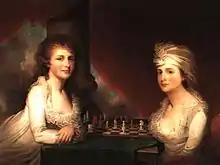James Markham Marshall
James Markham Marshall (March 12, 1764 – April 26, 1848) was a United States Circuit Judge of the United States Circuit Court of the District of Columbia.
James Markham Marshall | |
|---|---|
| Judge of the United States Circuit Court of the District of Columbia | |
| In office March 3, 1801 – November 16, 1803 | |
| Appointed by | John Adams |
| Preceded by | Seat established by 2 Stat. 103 |
| Succeeded by | Nicholas Battalle Fitzhugh |
| Personal details | |
| Born | James Markham Marshall March 12, 1764 Fauquier County, Colony of Virginia, British America |
| Died | April 26, 1848 (aged 84) Fauquier County, Virginia |
| Education | read law |
Education and career
Born on March 12, 1764, in Fauquier County, Colony of Virginia, British America,[1] Marshall was educated at home.[2] He served in the 1st Virginia Regiment,[1] commanded by Alexander Hamilton,[2] of the Continental Army in 1779 during the American Revolutionary war,[1] enlisting as a private and later becoming a lieutenant.[2] He read law and entered private practice in Fayette County, District of Kentucky, Virginia (State of Kentucky from June 1, 1792) starting in 1788,[1] after moving there with his father in 1785.[2] He continued private practice in Alexandria, D.C. (now Alexandria, Virginia) until 1801.[1]
Role in discussions concerning the "Spanish conspiracy"
Marshall bore a conspicuous part in the discussions concerning the “Spanish conspiracy.”[2] His statement that Don Diego de Gardoqui, the Spanish minister at Washington, had been in communication with John Brown looking to the withdrawal of Kentucky from the United States, was bitterly denounced by James Brown, afterward minister to France, which led to a challenge from Marshall, but the duel was prevented after the parties reached the ground.[2]
Service in Europe
Marshall was the commercial agent of New York City, New York, Boston, Massachusetts and Charleston, South Carolina in France during the Reign of Terror, and was employed by President George Washington as the agent of the United States to negotiate for the release of the Marquis de Lafayette, who was then a prisoner in Austria.[2] While in England he negotiated for the purchase of the Fairfax estates in the northern neck of Virginia, and he and his brother John received all the lands in “Leeds Manor,” where their posterity continue to reside.[2]
Federal judicial service
Marshall was nominated by President John Adams on February 28, 1801, to the United States Circuit Court of the District of Columbia, to a new seat authorized by 2 Stat. 103.[1] He was confirmed by the United States Senate on March 3, 1801, and received his commission the same day.[1] His service terminated on November 16, 1803, due to his resignation.[1]
Later career and death

Following his resignation from the federal bench, Marshall resumed private practice in Winchester, Virginia from 1803 to 1848.[1] He died on April 26, 1848, in Fauquier County.[1]
Family
Marshall was the son of the land surveyor and Revolutionary War Colonel, Thomas Marshall and younger brother of Chief Justice of the United States Supreme Court John Marshall.[2] After Marshall's return to Virginia in 1795, he married Hester, daughter of Robert Morris, the financier of the American Revolution.[2]
References
- James Markham Marshall at the Biographical Directory of Federal Judges, a public domain publication of the Federal Judicial Center.
- Wilson, J. G.; Fiske, J., eds. (1900). . Appletons' Cyclopædia of American Biography. New York: D. Appleton.
Sources
- James Markham Marshall at the Biographical Directory of Federal Judges, a public domain publication of the Federal Judicial Center.
- This article incorporates text from a publication now in the public domain: Wilson, J. G.; Fiske, J., eds. (1900). . Appletons' Cyclopædia of American Biography. New York: D. Appleton.
| Legal offices | ||
|---|---|---|
| Preceded by Seat established by 2 Stat. 103 |
Judge of the United States Circuit Court of the District of Columbia 1801–1803 |
Succeeded by Nicholas Battalle Fitzhugh |